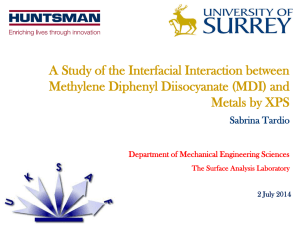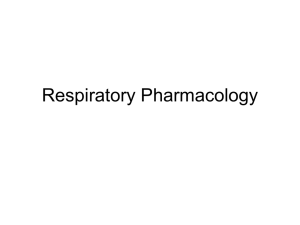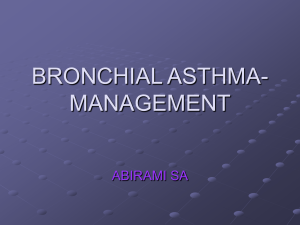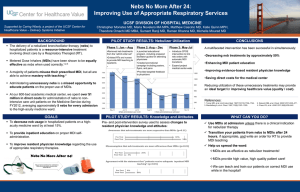inhaled drug guidelines - American College of Chest Physicians
advertisement
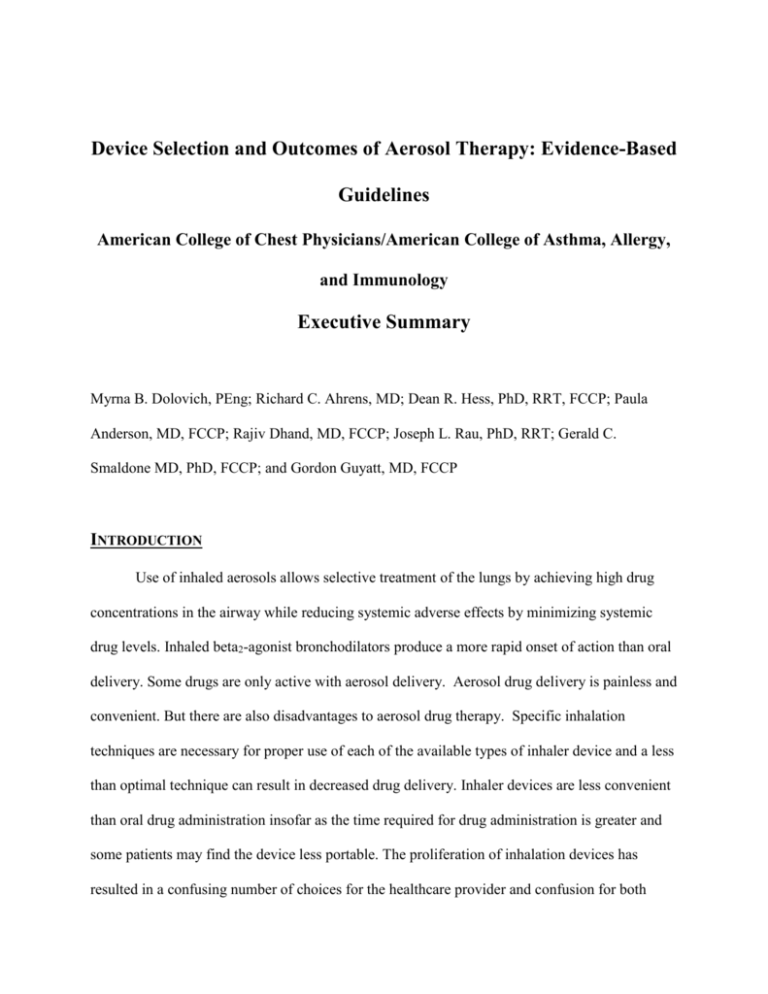
Device Selection and Outcomes of Aerosol Therapy: Evidence-Based Guidelines American College of Chest Physicians/American College of Asthma, Allergy, and Immunology Executive Summary Myrna B. Dolovich, PEng; Richard C. Ahrens, MD; Dean R. Hess, PhD, RRT, FCCP; Paula Anderson, MD, FCCP; Rajiv Dhand, MD, FCCP; Joseph L. Rau, PhD, RRT; Gerald C. Smaldone MD, PhD, FCCP; and Gordon Guyatt, MD, FCCP INTRODUCTION Use of inhaled aerosols allows selective treatment of the lungs by achieving high drug concentrations in the airway while reducing systemic adverse effects by minimizing systemic drug levels. Inhaled beta2-agonist bronchodilators produce a more rapid onset of action than oral delivery. Some drugs are only active with aerosol delivery. Aerosol drug delivery is painless and convenient. But there are also disadvantages to aerosol drug therapy. Specific inhalation techniques are necessary for proper use of each of the available types of inhaler device and a less than optimal technique can result in decreased drug delivery. Inhaler devices are less convenient than oral drug administration insofar as the time required for drug administration is greater and some patients may find the device less portable. The proliferation of inhalation devices has resulted in a confusing number of choices for the healthcare provider and confusion for both 2 clinicians and patients trying to use these devices correctly. Each type of aerosol device has its own advantages and disadvantages. Type Small volume jet nebulizer Advantages Patient coordination not required Effective with tidal breathing High dose possible Dose modification possible No CFC release Can be used with supplemental oxygen Can deliver combination therapies if compatible Ultrasonic nebulizer Patient coordination not required High dose possible Dose modification possible No CFC release Small dead volume Quiet Faster delivery than jet nebulizer No drug loss during exhalation Portable and compact Treatment time is short No drug preparation required No contamination of contents Dose-dose reproducibility high Some can be used with breath-actuated mouthpiece Pressurized metered dose inhaler Holding chamber or spacer Reduces need for patient coordination Reduces pharyngeal deposition Dry powder inhaler Breath-actuated Less patient coordination required Propellant not required Small and portable Short treatment time Dose counters in most newer designs Disadvantages Lack of portability Pressurized gas source required Lengthy treatment time Device cleaning required Contamination possible Not all medication available in solution form Does not aerosolize suspensions well Device preparation required Performance variability Expensive when compressor added in Expensive Need for electrical power source Contamination possible Not all medication available in solution form Device preparation required before treatment Does not nebulize suspensions well Possible drug degradation Potential for airway irritation with some drugs Coordination of breathing and actuation needed Device actuation required High pharyngeal deposition Upper limit to unit dose content Remaining doses difficult to determine Potential for abuse Not all medications available Many use CFC propellants in USA Inhalation can be more complex for some patients Can reduce dose available if not used properly More expensive than MDI alone Less portable than MDI alone Requires moderate to high inspiratory flow Some units are single dose Can result in high pharyngeal deposition Not all medications available PURPOSE The intent of this project was to assess the available scientific evidence addressing the question of whether device selection for aerosol therapy affects efficacy and to assess adverse effects of treatment. This was done through a systematic review of the relevant evidence from 3 randomized, placebo-controlled clinical trials (RCTs) and to provide general recommendations based on the trade-offs that this evidence provides. These recommendations relate to issues that clinicians should consider in selecting a particular therapeutic aerosol delivery device for their patients in each of several commonly encountered clinical settings. METHODOLOGY Medline, Embase, and the Cochrane Library were searched. Only RCTs in human subjects published in English were selected. The search identified an initial set of approximately 2,100 publications spanning the years 1972 to 2000. Reviews of each abstract for eligibility criteria identified 394 RCTs assessing inhaled corticosteroids, beta2-agonists, and anticholinergics delivered by metered dose inhaler (MDI), MDI with spacer/holding chamber, nebulizer, or dry powder inhaler (DPI). Studies were excluded if they only compared devices of the same type or only compared oral or parenteral therapy with the aerosol therapy. Of the 131 studies, only 59 proved to have useable data. Separate meta-analyses were carried out for each clinical setting. Studies were heterogeneous in purpose, design, and patient selection. Studies were thus grouped into general types based on the intended purpose and specific study design used: Type 1, Trials of device performance under conditions of actual clinical use Type 2, Trials of device performance in the clinical laboratory setting Type 2a, Studies that analyze differences in response variables Type 2b, Studies that estimate differences in clinical potency GRADING SCHEME 4 To grade the strength of the recommendations, the system adopted by the Health and Science Policy Committee of the American College of Chest Physicians was used. Grading of the strength of the recommendations is based on both the quality of the evidence and the net benefit of the diagnostic or therapeutic procedure: A - Strong recommendation B - Moderate recommendation C - Weak recommendation D - Negative recommendation I - No recommendation possible (Inconclusive) E/A - Strong recommendation based on expert opinion only E/B - Moderate recommendation based on expert opinion only E/C - Weak recommendation based on expert opinion only E/D - Negative recommendation based on expert opinion only Quality of the Evidence: Good - Evidence is based on good randomized controlled trials or meta-analyses Fair - Evidence is based on other controlled trials or RCT with minor flaws Low - Evidence is based on non-randomized, case-control, or other observational studies Expert opinion - Evidence is based on the consensus of the carefully selected panel of experts in the topic field. There are no studies that meet the criteria for inclusion in the literature review. 5 The levels of net benefit to the patient (adjusted for risk) are based on clinical assessment of the test or procedure: substantial, intermediate, small/weak, none, conflicting, negative. The strength of the recommendations is based on a scale based on the quality of evidence and net benefits. Net Benefit Substantial Intermediate Small/Weak None Conflicting Negative Quality Good A A B D I D of Fair A B C D I D Low B C C I I D Expert E/A E/B E/C I I E/D Evidence opinion AEROSOL DELIVERY OF SHORT-ACTING BETA2 AGONISTS IN THE HOSPITAL EMERGENCY DEPARTMENT Summary of RCT Results Delivery of beta2 agonists in the emergency department setting by nebulizers or MDI with holding chambers [AeroChamber, Volumatic, InspirEase] are equally effective for improving pulmonary function and reducing symptoms of acute asthma in both adult and pediatric patients. (Quality of Evidence: Good) Delivery of beta2 agonists in the emergency department setting by DPI (Rotahaler, Turbuhaler) has been inadequately studied, but trials in adults suggest they may be as effective as nebulizers or MDI + spacer/holding chambers. (Quality of Evidence: Low) 6 Nebulizer use in the emergency department setting is associated with greater increases in heart rate than the MDI with spacer/holding chamber suggesting that a larger dose is administered by nebulizers. (Quality of Evidence: Good). Recommendations 1. Both the nebulizer and MDI with spacer/holding chamber are appropriate for delivery of short-acting beta2 agonists in the emergency department. (Quality of Evidence: Good; Net Benefit: Substantial; Strength of Recommendation: A) 2. Because data for DPIs are limited, and high quality data for standard MDIs (without spacer/holding chamber) and breath-actuated MDIs are unavailable, we are unable to recommend use of these devices in the emergency department until more information is available. (Quality of Evidence: Low; Net Benefit: None; Strength of Recommendation: I) 3. Many factors would lead the clinician to appropriately select a particular type of aerosol delivery device in this setting. These include the patient’s ability to use the device correctly, the preferences of the patient for the device, the unavailability of an appropriate drug/device combination, the compatibility between the drug and delivery device, lack of time or skills to properly instruct the patient in the use of the device or monitor the appropriate use, and the cost of therapy. (Quality of Evidence: Low; Net Benefit: Substantial; Strength of Recommendation: B) AEROSOL DELIVERY OF SHORT-ACTING BETA2 AGONISTS IN THE INPATIENT HOSPITAL SETTING Summary of RCT Results 7 In the inpatient setting, the available evidence suggests no difference in pulmonary function response between using a nebulizer or a MDI with spacer/holding chamber for administering short-acting beta2-agonist therapy (Quality of Evidence: Good) Recommendations 1. Both nebulizers and MDIs with spacer/holding chambers are appropriate for use in the inpatient setting. (Quality of Evidence: Good; Net Benefit: Substantial; Strength of Recommendation: A) 2. Because data for DPIs, standard MDIs without spacer/holding chamber, and breath-actuated MDIs are inadequately studied in this setting, we are unable to recommend use of these devices in patients requiring hospitalization for asthma or COPD until more information is available. (Quality of Evidence: Low; Net Benefit: None; Strength of Recommendation: I) 3. Many factors would lead the clinician to appropriately select a particular type of aerosol delivery device in this setting. These include the patient’s inability to use the device correctly, the preferences of the patient for the device, the unavailability of the drug/device combination, the compatibility between the drug and delivery device, lack of time or skills to properly instruct the patient in the use of the device or monitor the appropriate use, and the cost of therapy. (Quality of Evidence: Low; Net Benefit: Substantial; Strength of Recommendation: B) INTERMITTENT VERSUS CONTINUOUS NEBULIZER DELIVERY OF BETA2 AGONISTS Summary of RCT Results Pulmonary function and asthma symptom scores show similar benefits for continuous and intermittent nebulization of short-acting beta2 agonists. (Quality of Evidence: Good) 8 The time requirements for staff administering and maintaining the therapy is less for continuous than intermittent nebulization. (Quality of Evidence: Good) Adverse effects of beta2 agonists are similar for continuous and intermittent nebulization of beta2 agonists. (Quality of Evidence: Good) The effect of continuous versus intermittent nebulization of beta2 agonists on admission rate from the emergency department, hospital length of stay, and cost of care have not been adequately studied (Quality of Evidence: Low) Recommendation 1. Frequent intermittent and continuous nebulization are both appropriate alternatives in severely dyspneic patients in the emergency department or ICU. (Quality of Evidence: Good; Net Benefit: Substantial; Strength of Recommendation: A) AEROSOLIZED BETA2 AGONISTS IN PATIENTS RECEIVING MECHANICAL VENTILATION Summary of RCT results In children and adults receiving mechanical ventilation, outcomes of beta2 agonist administration using an MDI with or without a spacer/holding chamber are no different than those observed following beta2 agonist administration with a nebulizer. (Quality of Evidence: Fair) High doses of beta2 agonists with a nebulizer are associated with a higher incidence of tachycardia and premature beats in mechanically ventilated patients, but there is no difference in adverse effects observed after administration of albuterol with an MDI 9 compared to those observed after administration of the drug with a nebulizer. (Quality of Evidence: Fair) There is insufficient evidence to guide the choice of MDI or nebulizer for patients receiving NPPV. (Quality of Evidence: Low) Recommendations 1. Both nebulizers and MDIs can be used to deliver beta2 agonists to mechanically ventilated patients. (Quality of Evidence: Fair; Net Benefit: Substantial; Strength of Recommendation: A) 2. Careful attention to details of the technique employed for administering drugs by MDI or nebulizer to mechanically ventilated patients is necessary, since multiple technical factors may have clinically important effects on the efficiency of aerosol delivery. (Quality of Evidence: Low; Net Benefit: Substantial; Strength of Recommendation: B) SHORT-ACTING BETA2 AGONISTS FOR ASTHMA IN THE OUTPATIENT SETTING Summary of RCT Results In the adult and pediatric outpatient population with asthma, available evidence comparing short-acting beta2 agonist delivery by MDI and DPI show no differences in pulmonary function responses, symptom scores, or heart rate. This remains true when analysis is restricted to Type 2b studies that estimate doses required to produce equal levels of response ("dose-axis comparisons") (Quality of Evidence: Good) In a limited number of Type 2 studies comparing short-acting beta2 agonists via MDI to MDI with spacer or holding chamber, pulmonary function responses were found to be comparable (Quality of Evidence: Low). 10 The use of nebulizers for delivery of short-acting beta2 agonists in the outpatient setting has not been adequately studied in RCTs. (Quality of Evidence: Low) Recommendations 1. For treatment of asthma in the outpatient setting, both the MDI, used with or without spacer/holding chamber, and DPI are appropriate for delivery of short-acting beta2 agonists. (Quality of Evidence: Good; Net Benefit: Substantial; Strength of Recommendation: A) 2. The appropriate selection of a particular type of aerosol delivery device in this setting include the patient’s ability to use the device correctly, the preferences of the patient for the device, the availability of the drug/device combination, the compatibility between the drug and delivery device, lack of time or skills to properly instruct the patient in the use of the device or monitor the appropriate use, the cost of the therapy and the potential for reimbursement. (Quality of Evidence: Low; Net Benefit: Substantial; Strength of Recommendation: B) INHALED CORTICOSTEROIDS FOR ASTHMA Summary of RCT Results For adult patients with asthma in the outpatient setting, there are no differences in pulmonary function response or symptom scores when the same dose of the same corticosteroid is used in a DPI or MDI with spacer/holding chamber. (Quality of Evidence: Good) Two studies indicated a significant patient preference for the DPI over the MDI with spacer/holding chamber. (Quality of Evidence: Good) No RCT adequately addressed the incidence of oral candidiasis. (Quality of Evidence: Low) Recommendations 11 1. For the treatment of asthma in the outpatient setting, both the MDI with a spacer/holding chamber and DPI are appropriate devices for the delivey of inhaled corticosteroids. (Quality of Evidence: Good; Net Benefit: Substantial; Strength of Recommendation: A) 2. For outpatient asthma therapy, selection of an appropriate aerosol delivery device for inhaled corticosteroids includes the patient’s ability to use the device correctly, the preferences of the patient for the device, the availability of the drug/device combination, the compatibility between the drug and delivery device, lack of time or skills to properly instruct the patient in the use of the device or monitor the appropriate use, the cost of therapy and the potential for reimbursement. (Quality of Evidence: Low; Net Benefit: Substantial; Strength of Recommendation: B) BETA2 AGONISTS AND ANTICHOLINERGICS FOR COPD Summary of RCT Results In the outpatient management of COPD patients with beta2 agonists and anticholinergics, the available evidence shows no differences in pulmonary function responses between delivery devices (Quality of Evidence: Good). Increases in heart rate were greater after albuterol by nebulizer than after MDI (Quality of Evidence: Good). Recommendations 1. For the treatment of COPD in the outpatient setting, the MDI, with or without spacer/holding chamber, the nebulizer, and the DPI are all appropriate for the delivery of inhaled beta2 agonists and anticholinergic agents. (Quality of Evidence: Good; Net Benefit: Substantial; Strength of Recommendation: A) 12 2. For outpatient COPD therapy, selection of an appropriate aerosol delivery device for inhaled beta2 agonists and anticholinergic agents includes the patient’s ability to use the device correctly, the preferences of the patient for the device, the availability of the drug/device combination, the compatibility between the drug and the delivery device, lack of time or skills to properly instruct the patient in the use of the device or monitor its appropriate use, the cost of therapy and the potential for reimbursement. (Quality of Evidence: Low; Net benefit: Substantial; Strength of recommendation: B) DISCUSSION Results of this systematic review of RCTs were essentially the same in each of the clinical settings evaluated above: none of the pooled meta-analyses showed a significant difference between devices in any efficacy outcome in any patient group. Thus, the relative effectiveness of delivery methods does not provide a clear basis for selecting one device over another. This does not mean that the choice for a specific patient of device does not seem to matter. In essence, this says that each of the devices studied can work equally well in that setting in patients who can use them appropriately. This is an important statement because most studies, especially in the outpatient setting, select for patients capable of using each of the devices with appropriate technique or train patients to use the appropriate technique. The RCTs included in this systematic review do not provide much information about who is likely to use one device or another properly, nor do they address many other considerations that are important for choosing a delivery device for a specific patient in a specific clinical situation. These include ability to use the device, patient preference, availability of equipment, and cost. While the clinician is still left to select the method of delivery based on these other 13 considerations, we have made general recommendations based on the results of the meta-analysis to guide the clinician in his/her selection of a delivery system. There are some obvious situations where device selection clearly does matter. For example, in each of the clinical situations studied, there are some devices that were studied little or not at all. This appears to indicate a consensus that RCTs are not needed to determine that some devices are inappropriate for that clinical situation. For example, it is clear that infants and toddlers have virtually no chance of using an MDI (without spacer or holding chamber) or a DPI properly. Similarly, there are virtually no RCTs studying the MDI (without spacer or holding chamber) in the emergency department since most clinicians believe that the severe dyspnea experienced by many asthma patients in that setting would prevent them from using this device properly. How does one select an aerosol delivery device for the patient? What practical advice can be given for device selection when the best evidence shows no difference in outcomes between devices? In the following list, we review the important issues for clinicians to consider when selecting an aerosol delivery device. When selecting an aerosol delivery device, the following questions should be considered. 1. In what devices is the desired drug available? 2. Keeping in mind the age of the patient and the clinical setting, what device(s) is the patient likely to be able to use properly? 3. For which device(s) is reimbursement available? 4. Which device(s) is least costly? 5. Can all types of inhaled asthma/COPD drugs prescribed for the patient (short-acting beta agonist, corticosteroid, anti-cholinergic and long-acting beta agonist) be 14 delivered with the same type of device: nebulizer, manually actuated MDI, MDI with spacer/holding chamber, or breath-actuated device (automatically activated MDI or DPI)? Using the same type of device for all inhaled drugs may facilitate patient teaching and decrease the chance for confusion among devices that require different inhalation techniques. 6. Keeping in mind the time required for drug administration and for cleaning of the device and portability of the device, which device is most convenient for the patient or family (outpatient use) or medical staff (acute care setting) to use? 7. Does the patient or clinician have any specific device preferences? Whichever device is chosen, proper patient education on its use is critical and that assessment of inhalation technique should be part of subsequent visits to the physician. Therefore, physicians, respiratory therapists, and nurses caring for patients with respiratory diseases should be familiar with issues related to performance and correct use of aerosol delivery devices. Patients must be adequately instructed in the correct use of aerosol delivery devices. If the selected delivery device should fail to provide satisfactory treatment or result in unacceptable side effects for the patient, both clinician and patient should recognize that there are other, effective options.
